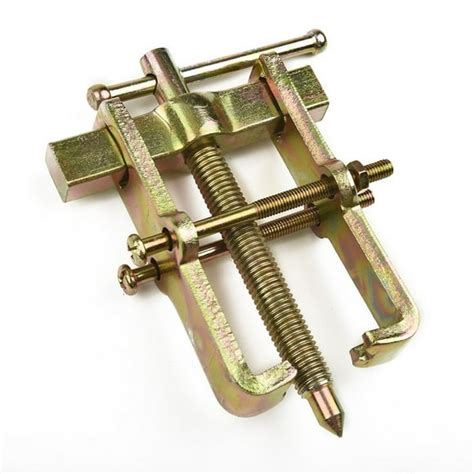The In-Depth Guide to Needle Bearing Pullers: A Comprehensive Resource for Professionals
Introduction
Needle bearings are indispensable components in various mechanical systems, known for their small size, high load capacity, and low friction. However, extracting and installing these bearings often poses challenges, necessitating specialized tools such as needle bearing pullers. This guide delves into the intricacies of needle bearing pullers, providing a comprehensive understanding of their types, applications, and effective usage techniques.
Types of Needle Bearing Pullers
Needle bearing pullers come in diverse designs, each tailored to specific bearing applications. Here are the most common types:
-
Manual Pullers: These handheld tools employ a simple mechanism to exert force on the bearing, enabling manual extraction.
-
Hydraulic Pullers: These pullers utilize hydraulic pressure to generate high forces, making them suitable for heavy-duty applications.
-
Mechanical Pullers: Leveraging mechanical advantage, these pullers offer precise control over force application.
-
Collet Pullers: Designed for small bearings, collet pullers utilize a gripping system to extract bearings without damaging them.
Applications of Needle Bearing Pullers
Needle bearing pullers find widespread use across industries, including:

-
Automotive: Extracting bearings from engines, transmissions, and other automotive components.
-
Industrial Machinery: Removing bearings from pumps, compressors, and other heavy equipment.
-
Aerospace: Disassembling bearings in aircraft engines and other critical systems.
-
Construction Equipment: Servicing bearings in construction machinery, such as excavators and cranes.
-
Manufacturing: Facilitating bearing maintenance in production lines.
Choosing the Right Needle Bearing Puller
Selecting the appropriate needle bearing puller is crucial for efficient and safe operation. Consider the following factors:

-
Bearing Dimensions: Ensure the puller is compatible with the size and type of bearing being removed.
-
Force Required: Determine the amount of force necessary to extract the bearing, which depends on the bearing's fit and location.
-
Application Environment: Choose a puller that can withstand the specific operating conditions, such as exposure to chemicals or extreme temperatures.
Tips and Tricks for Using Needle Bearing Pullers
-
Lubricate the Puller: Apply a thin layer of lubricant to the puller's threads and contact surfaces to reduce friction and prevent damage.
-
Use the Correct Jaws: Select jaw attachments that fit the bearing snugly without causing damage.
-
Apply Force Gradually: Exert pressure on the puller steadily to avoid sudden, forceful extraction that could damage the bearing or surrounding components.
-
Check Alignment: Before applying force, ensure the puller is aligned perpendicular to the bearing to prevent bending or deformation.
Interesting Stories
-
The Apprentice's Mishap: An apprentice, using an improper puller, attempted to extract a bearing from a critical aircraft component. The bearing shattered upon extraction, causing extensive damage and delaying the aircraft's scheduled maintenance. This incident highlights the importance of using the correct tools for the job.

-
The Rusty Bearing Blunder: A technician encountered a rusted bearing that refused to budge even after extensive force was applied. Undeterred, he soaked the bearing overnight in a penetrating oil, which allowed it to be extracted easily the next day. This story emphasizes the need for patience and the use of appropriate techniques when dealing with stubborn bearings.
-
The Overzealous Mechanic: In a rush to complete a repair, a mechanic used excessive force when extracting a bearing. This resulted in the bearing being damaged and the surrounding housing being cracked. This incident serves as a reminder to always prioritize safety over speed and to avoid using excessive force.
Common Mistakes to Avoid
-
Using the Wrong Puller: Attempting to extract bearings with an incompatible puller can damage both the bearing and the puller.
-
Applying Excessive Force: Overstepping the recommended load capacity of the puller can lead to bearing damage or puller failure.
-
Ignoring Safety Precautions: Failure to wear appropriate safety gear, such as gloves and eye protection, can result in injury during use.
Step-by-Step Approach to Using a Needle Bearing Puller
-
Prepare the Puller: Lubricate the puller and select the appropriate jaws for the bearing.
-
Position the Puller: Align the puller perpendicular to the bearing and secure it firmly.
-
Apply Force: Gradually apply force to the puller, ensuring it is evenly distributed across the jaws.
-
Monitor the Extraction: Observe the progress of the extraction and adjust the force accordingly.
-
Remove the Bearing: Once the bearing is loose, carefully remove it from the shaft or housing.
Call to Action
Needle bearing pullers are essential tools for professionals working with bearings. By understanding the different types, applications, and usage techniques, you can effectively extract and install bearings, ensuring optimal performance and longevity of your equipment. Utilize the information provided in this comprehensive guide to become a proficient needle bearing puller user, safeguarding your time, resources, and reputation.

